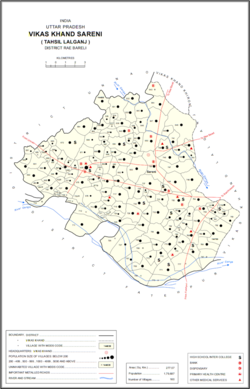|
Rani Khera, Sareni
Rani Khera is a village in Sareni block of Rae Bareli district, Uttar Pradesh, India.[2] It is located 27 km from Lalganj, the tehsil headquarters.[3] As of 2011, it has a population of 1,451 people, in 278 households.[2] It has one primary school and no healthcare facilities.[2] It belongs to the nyaya panchayat of Murarmau.[4] The 1951 census recorded Rani Khera as comprising theee hamlets, with a population of 663 people (344 male and 319 female), in 127 households and 111 physical houses.[5] The area of the village was given as 316 acres.[5] 80 residents were literate, all but four of them males.[5] The village was listed as belonging to the pargana of Sareni and the thana of Sareni.[5] The 1961 census recorded Rani Khera as comprising two hamlets, with a total population of 815 people (381 male and 434 female), in 137 households and 126 physical houses.[6] The area of the village was given as 319 acres.[6] The 1981 census recorded Rani Khera as having a population of 1,047 people, in 166 households, and having an area of 124.23 hectares.[3] The main staple foods were given as wheat and rice.[3] The 1991 census recorded Rani Khera as having a total population of 1,357 people (720 male and 637 female), in 238 households and 238 physical houses.[4] The area of the village was listed as 123 hectares.[4] Members of the 0-6 age group numbered 237, or 17% of the total; this group was 52% male (124) and 48% female (113).[4] Members of scheduled castes made up 19% of the village's population, while no members of scheduled tribes were recorded.[4] The literacy rate of the village was 54% (469 men and 268 women).[4] 584 people were classified as main workers (389 men and 195 women), while no workers were classified as marginal workers; the remaining 773 residents were non-workers.[4] The breakdown of main workers by employment category was as follows: 223 cultivators (i.e. people who owned or leased their own land); 222 agricultural labourers (i.e. people who worked someone else's land in return for payment); 19 workers in livestock, forestry, fishing, hunting, plantations, orchards, etc.; no workers in mining and quarrying; 26 household industry workers; one worker employed in other manufacturing, processing, service, and repair roles; one construction worker; 15 employed in trade and commerce; three employed in transport, storage, and communications; and 74 in other services.[4] References
|
||||||||||||||||||||||||||||||||||

